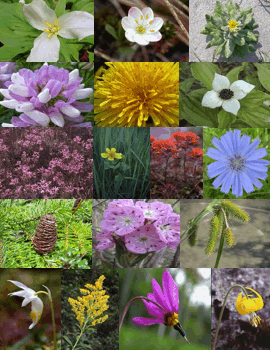Cerastium nutans var. nutans
nodding chickweed
Caryophyllaceae (Pink family)
Introduction to Vascular Plants
nodding chickweed
Caryophyllaceae (Pink family)
Introduction to Vascular Plants
Map
Distribution of Cerastium nutans var. nutans
Click here to view the full interactive map and legend
Species Information
General:
Annual herb from a short, slender taproot; stems ascending to erect, glandular-hairy to somewhat soft-hairy, 1 to several, simple or basally branched, 5-25 cm tall.
Leaves:
Basal and lower stem leaves spoon-shaped to oblanceolate, 6-30 mm long, broadly short-stalked; stem leaves opposite, several pairs, linear-lanceolate to egg-shaped, unstalked; stipules lacking.
Flowers:
Inflorescence several in a loose, leafy, bracted cluster; stalks glandular soft-hairy; petals 5, white, usually sharply deflexed at the tips, 2-cleft, 6-10 mm long, occasionalály lacking; sepals 5, elliptic, 4-5 mm long, generally glandular soft-hairy.
Fruits:
Capsules cylindric, curved at maturity, 7-12 mm long, 10-valved; seeds light brown, 0.5-0.7 mm long.
Ecology
Ecological Framework for Cerastium nutans var. nutans
The table below shows the species-specific information calculated from
original data (BEC database) provided by the BC Ministry of Forests and Range.
(Updated August, 2013)
The table below shows the species-specific information calculated from
original data (BEC database) provided by the BC Ministry of Forests and Range.
(Updated August, 2013)
| Site Information |
Value / Class |
||
|
Avg |
Min |
Max |
|
| Elevation
(metres) |
1145 | 847 | 1710 |
| Slope
Gradient (%) |
5 | 0 | 12 |
|
Aspect (degrees) |
190 | 160 | 220 |
| Soil
Moisture Regime (SMR) [0 - very xeric; 4 - mesic; 8 - hydric] |
4 | 4 | 5 |
| Modal
Nutrient Regime
Class |
D | ||
| #
of field plots species was recorded in: |
4 | ||
| Modal
BEC Zone Class |
PP | ||
|
All BEC Zones (# of stations/zone) species was recorded in |
IDF(1), MS(1), PP(1) | ||
|
Source:
Klinkenberg 2013
|
|||
Habitat and Range
Moist to mesic streambanks, grasslands and open forests in the steppe and lower montane zones; infrequent in SC BC, rare in the Peace River area; N to S AK and S NT, E to PQ and NS, and S to SC, FL, UT, TX, AZ and OR.Status Information
Synonyms
Synonyms and Alternate Names:
Cerastium longepedunculatum Muhl. ex Britton
Cerastium nutans var. occidentale B. Boivin
